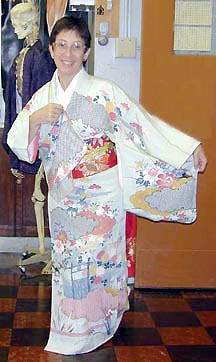Student
Experiment Flies On NASA Space Shuttle!
Project URL:
http://motthall.org/curriculum/STARS/STARS&NASA.htm
How
it works:
Listservs for science teachers often provide great leads to exciting
projects. One of these lists provided information about NASA's
outreach to New York City schools after the tragedy of September 11th.
NASA was encouraging schools to apply to send a student scientific
experiment into space aboard a space shuttle. They have been including
student experiments on the shuttle for a number of years as part of a program
called SEM (Space Experiments Module). The Mott Hall-CCNY STARS (Student Apprenticeships
In Research) students, recognized that this was a life-affirming,
confidence-building opportunity, and, after several months of hard work,
they produced a creative and rigorous experiment. The experiment measures the
ability of various natural and synthetic fabrics to absorb high-energy
radiation that is encountered in the shuttle's low earth orbit.
The
use of technology was an integral part of the success in this program.
Almost all communications with NASA were carried on via
e-mail. Through a video conference with NASA SEM
personnel, the students and teacher received help in the planning stage. The
experiment required the procurement of small device--called
dosimeters--for measuring radiation exposure, as well as samples of many kinds of fabrics to wrap around the dosimeters.
Through extensive web searches and pleading e-mails, two generous
mentors were located: a dosimetry scientist and a materials
chemical engineer who
provided the needed materials and also wonderful advice via the
Internet, without ever having met us. All the extensive data recording dosimeter
numbers, fabric samples, thickness, and density were all recorded
into a Microsoft Excel worksheet. This information will be used to
analyze data when the experiment is returned after the shuttle flight.
After the NASA
SEM team traveled to New York to help pack up the experiment and
send it to Cape Kennedy, they provided digital pictures, via the
Internet,
of the process of integrating the experiment into the SEM module and
then into the Space Shuttle experimental bridge.
Standards addressed:
This is an integrated studies activity that fulfills standards of
science inquiry, science as a human activity, the use of technology,
and many physics and engineering concepts.
.
Materials used:
Materials include computers with Internet access for the video
conferences, the experimental materials of fabrics and
dosimeters, a digital camera, and computer camera, a microphone, a digital
projector, and Microsoft Excel and Word software for project documentation.
The
students:
Mott Hall is a science, math, and technology magnet school for
Community School District 6, which serves the North Harlem-Washington
Heights neighborhood of Manhattan. It enrolls 450 students in grades
four through eight. Seventh grade students participated in this project.
Approximately 85 percent of the student population are first- or second-
generation immigrants from Latin American, especially the Dominican
Republic. Approximately 10% are African Americans. The others are almost all immigrants from other
countries. More than 60% of the students are girls.
Overall value:
The exciting and motivating opportunity for middle school students to actually design and
construct an experiment that will be launched into space aboard a NASA
research shuttle is a once-in-a-lifetime event. How better to gain and
appreciation for (and, hopefully, a love of) scientific investigation than
to do real science and be responsible for reporting your results to
the world. The power of technology to connect students with the world is powerfully demonstrated by this kind of
program.
Tips:
Grab opportunities for "authentic" learning! Don't be
humble, but be prepared for a lot of hard work.
|

About the teacher:
Susan Herzog is a middle school science teacher at the Mott Hall
School-IS223. In addition to teaching seventh grade life science, Susan is
the Director of Mott Hall-CCNY STARS, a collaboration between the two
schools in which eighth grade students spend three hours a week working with mentors in CCNY Science
and Engineering Research laboratories. She has a bachelor's degree
and a master's in secondary science teaching from the City College of the
City University of New York. She entered teaching as a second
career at age 48, has been teaching for nine years, and is a pioneer in the use of the Internet in her
school.
E-mail:
sherzog@hotmail.com
Subject
Areas:
Science
Technology
Grade
Levels:
8
|